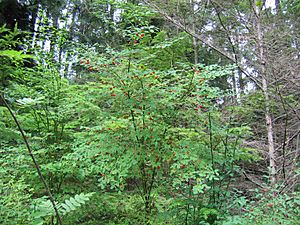Red huckleberry facts for kids
Quick facts for kids Red huckleberry |
|
|---|---|
 |
|
| Scientific classification | |
| Kingdom: | |
| (unranked): | |
| (unranked): | |
| (unranked): | |
| Order: | |
| Family: | |
| Genus: | |
| Species: |
V. parvifolium
|
| Binomial name | |
| Vaccinium parvifolium Sm.
|
|
The red huckleberry (Vaccinium parvifolium) is a cool plant found in western North America. It grows in forests from southeastern Alaska and British Columbia all the way down to central California.
You'll often spot it in places like the Oregon Coast Range. It likes to grow in rich soil, especially where there's decaying wood or on old, rotten logs. You can find it from sea level up to about 1,820 meters (5,970 feet) high.
Contents
What Does the Red Huckleberry Look Like?
The red huckleberry is a deciduous shrub, which means its leaves fall off in the autumn. It can grow up to 4 meters (13 feet) tall. Its new branches are bright green and have a unique angular shape.
Leaves and Flowers
The leaves are shaped like an oval or a long ellipse. They are usually between 9 mm (0.35 inches) and 30 mm (1.2 inches) long, and 4 mm (0.16 inches) to 16 mm (0.63 inches) wide. The edges of the leaves are smooth.
The flowers are small and bell-shaped, about 4 mm (0.16 inches) to 5 mm (0.20 inches) long. They can be yellow-white or pinkish-white, often with pink tips.
Tasty Red Berries
The fruit of the red huckleberry is a small, edible berry. It's usually bright red to orange and measures about 6 mm (0.24 inches) to 10 mm (0.39 inches) across. These berries are a favorite snack for many animals!
Who Eats Red Huckleberries?
Many animals love to eat red huckleberries. Birds, bears, and small mammals enjoy the berries. Deer and some farm animals also munch on the leaves.
Traditional Uses by Native Americans
Indigenous peoples of North America have used the red huckleberry for a very long time. Tribes like the Bear River Band, Karuk, and Pomo found the plant and its fruit super useful.
The bright red, tart berries were a big part of their diet all year round. People ate fresh berries in large amounts. They even used them for fish bait sometimes, because the berries looked a bit like salmon eggs. Berries were also dried to save for later. Dried berries could be stewed into sauces or mixed with salmon roe and oil for winter feasts.
The bark or leaves of the plant were used to make a bitter tea, which was a traditional remedy for the common cold. Sometimes, the leaves were even smoked. The branches were used as brooms, and the thin twigs helped to tie Western skunk cabbage leaves together to make berry baskets.
Today, you can still eat huckleberries fresh or dried. They are also used to make delicious teas or jellies.
Growing Red Huckleberries
Vaccinium parvifolium is sometimes grown by people who specialize in plants. It's used in natural landscaping, native plant gardens, and projects that help bring nature back to an area. Another similar plant that's often grown is the Vaccinium ovatum.
Even though they are popular, red huckleberries are not grown on huge farms like other fruits. It's tricky to grow them on a large scale. They need acidic soil (with a pH between 4.5 and 6) and don't like their roots to be disturbed.
Images for kids






